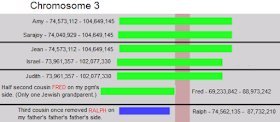What we did have are overlapping matches on that segment with a half second cousin who has only one Jewish grandparent, on our father's maternal side, and a with a third cousin once removed on our father's paternal side.
The thing is, the triangulation is crazy. Amy and Jean match Ralph and not Fred. Sarajoy, Judith and I match Fred and not Ralph. The five of us are not the group that they seem to be vis-a-vis David. I was surprised that Sarajoy is paired with Judith and me, not with Amy and Jean - her end point is the same as theirs not ours.
The matches for David's maternal grandmother were almost precisely the same, so clearly it's all on his grandmother's side. I concluded with a call for possible explanations, hoping to get more that the usual "If it doesn't make sense it must be IBS and not indicative of real common ancestry." No one ventured a guess, not on the post nor on Facebook.
So today, I want to have a look at the other segment where David matches multiple Pikholz descendants, all over 10 cM. That would be Chromosome 22.

Here we have two of my sisters, our father's brother, our father's first cousin Herb, our second cousin Terry (her father is a first cousin of both Herb and Uncle Bob) and two other Pikholz descendants, Bonnie and Rita. here everyone matches everyone in a fine triangulation, except Terry and Herb who do not match each other. I cannot imagine how that can be and I'd be pleased to see some theories. (Once again, David's maternal grandmother has much the same group of matches.)
Jean and Judith have identical segments. Herb and Rita - an odd combination - have the same starting point.
Our family group are all descended from my great-grandfather Hersch Pikholz, whose parents are indeterminate Pikholz cousins born probably 1815 or so. Rita's Pikholz ancestor is Nachman Pikholz, born about 1795 and Bonnie is almost certainly from Berl Pikholz born about 1789. (We know who Bonnie's great-great-grandfather is - the only tiny uncertainty is whether he is a son of Berl.)
Bonnie has a handful of third cousins who are not represented in this segment and Rita has one second cousin and several fourth cousins who are also not represented here.
What I'm thinking is that since David and his grandmother match descendants of three Pikholz who lived around 1800 all on one 10+ cM segment, it is likely that our most recent common ancestor precedes those three Pikholz. Not necessarily, but highly likely since 1800 is about the point when we know many of the surnames.
That, of course, is the conclusion regarding so many of the folks who show up with a large number of Pikholz DNA matches.
Housekeeping notes
This Tuesday, 27 October, I'll be speaking in Hebrew about Jewish Genetic Genealogy for the Jerusalem branch of the Israel Genealogy Society. The meeting begins at 5:30 at Yad Ben Zvi, Ibn Gevirol 14. I'll be speaking in Hebrew.
The following day I wail be speaking in Carmiel, at Yad LeBanim, at seven o'clock. Also in Hebrew.














